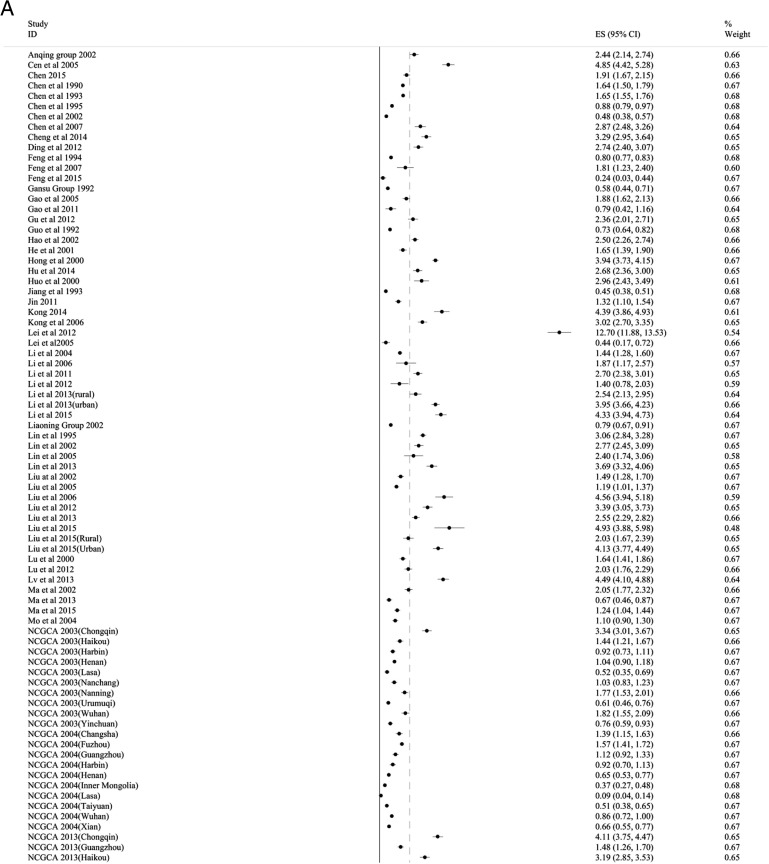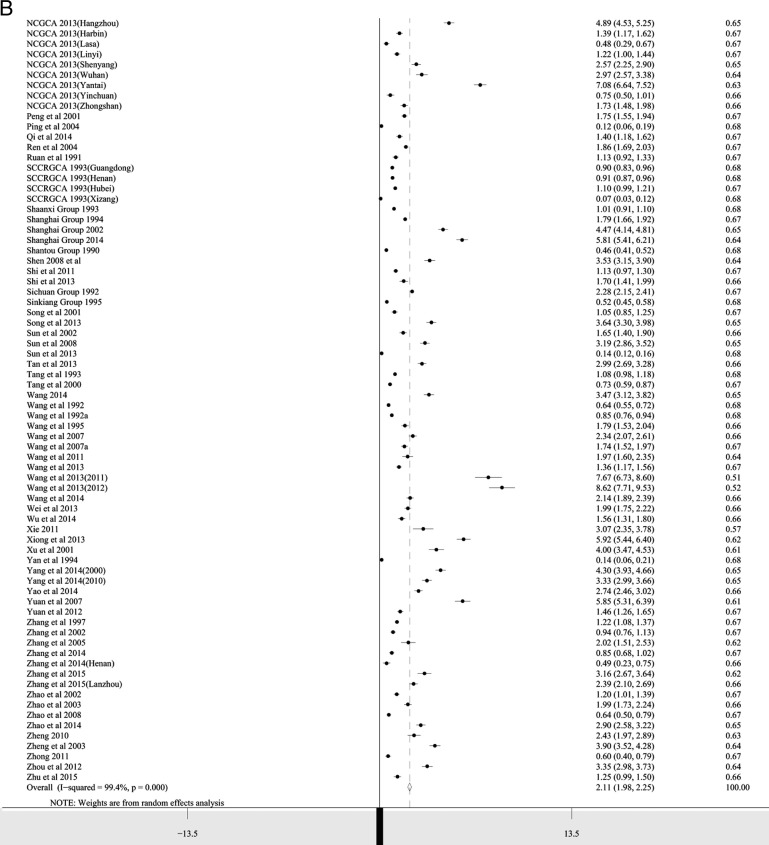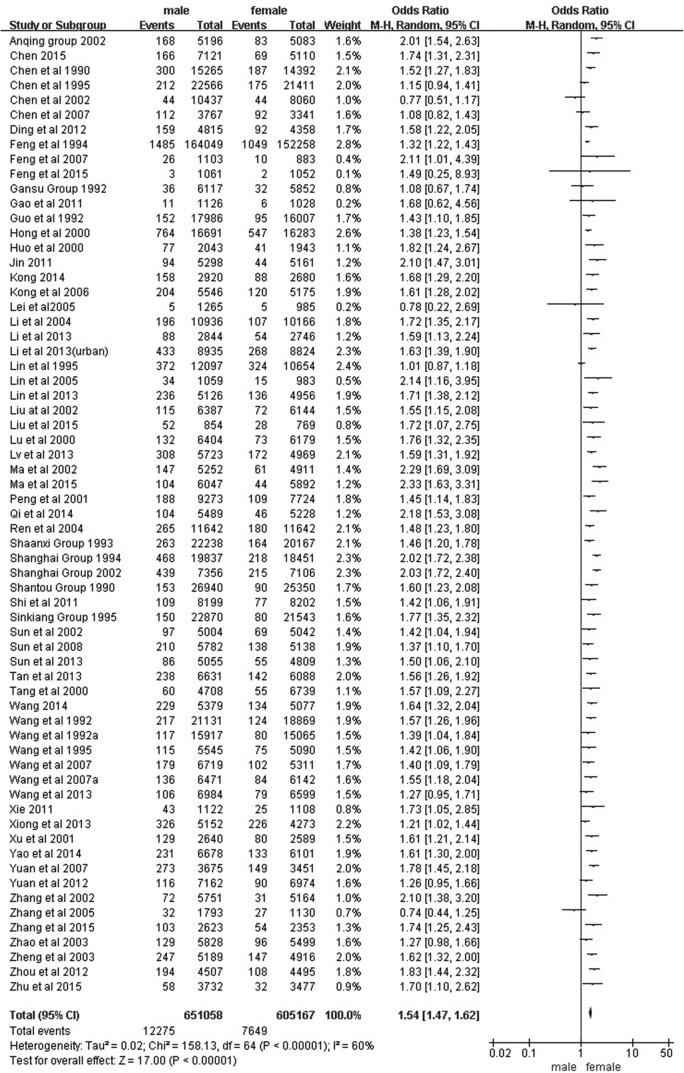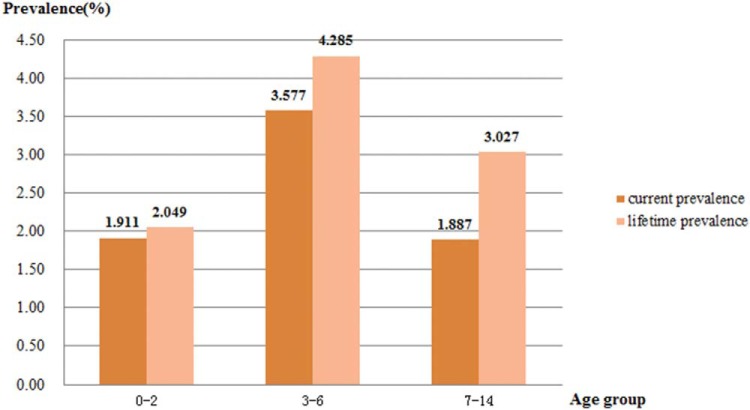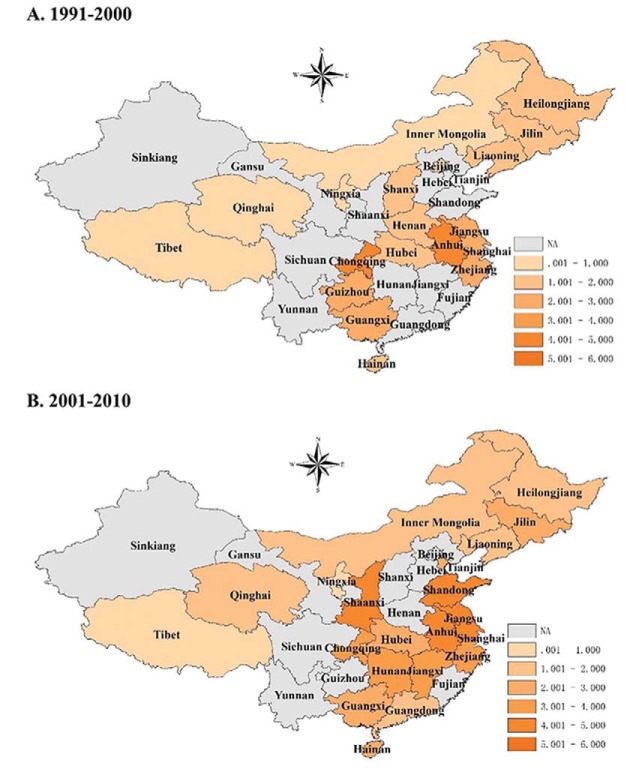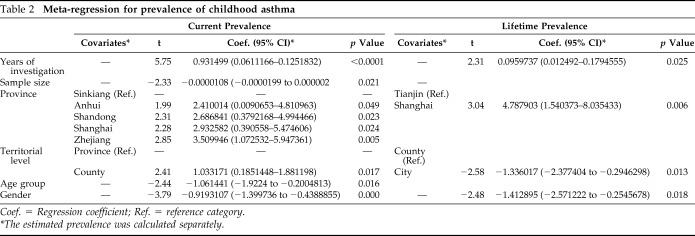Abstract
Background:
After the promotion of the two-child policy in recent years, the population of children in mainland China was bound to have a rapid growth, which would bring great challenges to public health. A number of cross-sectional studies on the epidemic of childhood asthma in mainland China were recently conducted, and varied prevalences were reported. Thus, knowing the epidemiology of childhood asthma in mainland China is of great necessity.
Objective:
Our study aimed to summarize the pooled prevalence of childhood asthma in mainland China and its time trend, gender difference, regional distribution, and age structure.
Methods:
Studies that reported the prevalence of childhood asthma in mainland China were identified via a systematic data base search through July 1, 2016. Meta-analysis was used to estimate the prevalence of childhood asthma and its subgroups, including gender, age groups, years, and regions. The regional distribution of the prevalence was set by province with the help of a geographic mapping software. The autoregressive integrated moving average model was used to predict the current prevalence of asthma.
Results:
A total of 117 studies published from 1988 to 2014 in mainland China with a total sample size of 2,678,696 were included. The overall current prevalence and lifetime prevalence of childhood asthma was 2.112% (95% confidence interval [CI], 1.977–2.247%) and 2.502% (95% CI, 2.166–2.838%), respectively. The difference of the prevalences between male and female patients was significant: odds ratio 1.54 (95% CI, 1.47–1.62) for the current prevalence and odds ratio 1.61 (95% CI, 1.47–1.77) for the lifetime prevalence.
Conclusion:
The prevalence of childhood asthma in mainland China was low but has been increasing remarkably since 1998. Boys are more likely to have asthma throughout most of their childhood. Preschoolers (3–6 years old) showed a higher prevalence than the other age groups. The current prevalence of childhood asthma probably increased slightly from 2017 to 2019.
Keywords: Childhood, children, asthma, prevalence, epidemiology, China, meta-analysis
Asthma is a chronic airway inflammation characterized by variable symptoms, such as wheezing, breathlessness, chest tightness, cough, and reversible airflow limitation. The prevalence and burden of asthma have markedly increased recently in children.1,2 The International Study of Asthma and Allergies in Childhood (ISAAC) phase III reported that 13.7% of the population of children worldwide experienced asthmatic symptoms. As the second most costly respiratory disease,2 and one of the top 10 causes of disability-adjusted life years lost among the population ages 5–14 years, asthma accounted for 0.9% of the overall global estimate of disability-adjusted life years lost in 2010.3
After the formation of the People's Republic of China, the disease spectrum shifted from infectious diseases to chronic diseases in an unprecedentedly fast speed.4 Consequently, the prevalence, mortality, and burden of asthma showed a remarkable increase. The Global Initiative for Asthma3 focused on the global burden of asthma, and reported that China possessed the highest asthma case fatality rate (36.7 deaths per 100,000 patients with asthma) in the 5–34-year-old age group. After promoting the two-child policy, the population of children in mainland China grew rapidly, which brought great challenges to public health.
Assessing the situation of the epidemiology of common pediatric diseases, including asthma, is a critical task. Three national surveys on the prevalence of childhood asthma were conducted in 1990, 2000, and 20105–7_ENREF_5 showed the current prevalences as 0.91% (1990), 1.54% (2000), and 2.32% (2010), and the lifetime prevalences as 1.97% (2000) and 3.02% (2010), which presented an increasing trend and indicated higher burdens in all directions. Studies based on different regions in mainland China showed great differences. The current prevalence in Xining, Qinghai, was 0.665% in 2013,8 whereas it was 8.618% in Weihai, Shandong.9 However, the detailed epidemic patterns of both the time trend and regional variation are unclear.
Yangzong et al.10 summarized_ENREF_10 the epidemiology of childhood asthma in China in 2012 and noted a generally low prevalence. However, the regional variations and time trend in the prevalence were not summarized in the article. Knowing the geographic distribution of the prevalence is important and significant for the health resource allocation because of the great differences among the elevations, climates, pollution levels, economic development, and living habits of regions in mainland China. Similarly, the time trend provides valuable information on the epidemic of the disease, public health planning, and etiologic inference of asthma. The epidemiology status of childhood asthma in mainland China may have changed, and new studies11–13 have been conducted. A meta-analysis is necessary for a better understanding of the epidemiology of childhood asthma in mainland China.
This study aimed to summarize the pooled prevalence and other epidemic characteristics of childhood asthma in mainland China, reveal the status quo, and contribute to future practices in health decision-making. The overall prevalence and its time trend, predicted prevalence, gender difference, regional distribution, and age structure are studied. The results may contribute to future practices in health decision-making.
METHOD
Search Strategy
PubMed (Bethesda, MD) and Embase (London, UK & Amsterdam, Netherlands), with Chinese National Knowledge Infrastructure (Beijing, China), Chinese Biologic Medical Literature (Beijing, China), Chinese Wanfang (Beijing, China), and Chongqing VIP (Chongqing, China) data bases were searched from inception to July 1, 2016. The key words searched included “asthma,” “bronchial disease,” “wheezing,” “prevalence,” “incidence,” “epidemiology,” “epidemiologic,” “occurrence,” “China,” and “Chinese,” with the language restricted to English or Chinese. The reference lists of the studies included were reviewed to identify other potentially eligible studies. Two authors (Z.L., X.G.) independently completed the literature search and study selection. X. Guo, Z.L., and W. Ling are co–first authors.
Selection Criteria
Inclusion Criteria.
Inclusion criteria were the following: (1) Cross-sectional studies among children ages 0–14 years old reported with a prevalence of childhood asthma; (2) in mainland China (excluding Hong Kong, Macao, and Taiwan); and (3) diagnosed as using two-stage screening (a questionnaire for primary screening and formal diagnosis by physicians according to the conventional diagnostic criteria in China. See Online Supplemental Material).
Exclusion Criteria.
Exclusion criteria were the following: (1) Repetition; when the same data were retrieved from both a national level study and a provincial study or from a provincial level study and a city level study, we gave preference to the provincial level study, which possesses more robust data and better reliability; (2) specific populations, such as hospital in-patients or volunteers; (3) studies that corresponded to one of these clauses, (a) diagnostic criteria unclear or (b) unconventional diagnostic tools; (4) small sample sizes (<1000); and (5) unclear survey date.
Data Extraction
Two researchers (Z.L., X.G.) independently extracted the following data: first author, survey date, territorial level, province, urban or rural, age range, screening tool, diagnostic tool, sampling method, participation rate, sample size (total, boys or girls, urban or rural), case (current or lifetime), and prevalence of childhood asthma (current or lifetime, boys or girls, urban or rural, typical asthma or cough-variant asthma, age group). A third researcher (J. Long) was involved in reaching a consensus when differences in opinions occurred.
Quality Assessment
The quality of the studies included were assessed by using the “The Strengthening the Reporting of Observational Studies in Epidemiology (STROBE) statement” guidelines,14 a scoring criterion that presents the risk of selection and performance bias. The scale contains five items that describe the sample population (0–2 points), sample size (0–2 points), participation rate (0–2 points), outcome assessment (0–2 points), and analytical methods to control the bias (0–2 points). For each item, low risk is 2 points, moderate risk is 1 point, and high risk is 0 point.
Statistical Analysis
The pooled prevalences were estimated via STATA 12.0 (Stata Corp., College Station, TX). A random-effects model was used when the heterogeneity was significant (I2 ≥ 50% or p < 0.05), otherwise a fixed-effects model was used. Funnel plot, Egger's and Begg's tests, sensitivity analysis, and meta-regression were conducted to estimate the publication bias and to explore the sources of heterogeneity. Review Manager 5.0 software (The Cochrane Collaboration; The Nordic Cochrane Centre, Copenhagen, Denmark) was used for comparing the differences of the prevalences by gender and by area. When I2 was ≥50%, we used the random-effects model to access the odds ratios (OR) with 95% confidence intervals (CI), otherwise, the fixed-effects model was used. The autoregressive integrated moving average (ARIMA) model was used to fit the pooled prevalence data from 1996 to 2011, and prevalence data from 2012 to 2014 were used to validate the models. Through EViews version 6.0 (Quantitative Micro Software Co., US), the ARIMA model was finally determined to be (4, 1, 3) which was the best model to predict the prevalence data 5 years into the future. When considering the difference in the regional distributions, the pooled prevalence of different regions was set by province in mainland China by using ArcGis 10.2 software (Stanford University, CA).
RESULTS
Study Selection
A detailed flowchart of the search and selection process is shown in Fig. 1. A total of 6044 reports were identified from the initial searches of the data bases, and 3216 reports were excluded as duplicates among the data bases; then, 2563 unrelated reports were excluded based on the titles and abstracts. After carefully viewing the full text of the remaining articles (n = 265), we excluded 148 articles; 117 studies remained.
Figure 1.
Search strategies.
Description of Included Studies
The 117 studies5–9,11–13,15–123 (115 in Chinese and 2 in English) involved 22 provinces, 4 municipalities, and 5 autonomous regions, with a sample size of 2,678,696, and ranged from 1988 to 2014. In the quality assessment, 32 studies obtained 8 points, 31 studies obtained lower points, and 54 studies obtained higher points. More details are shown in Table 1.
Table 1.
The prevalence of childhood asthma and subgroups
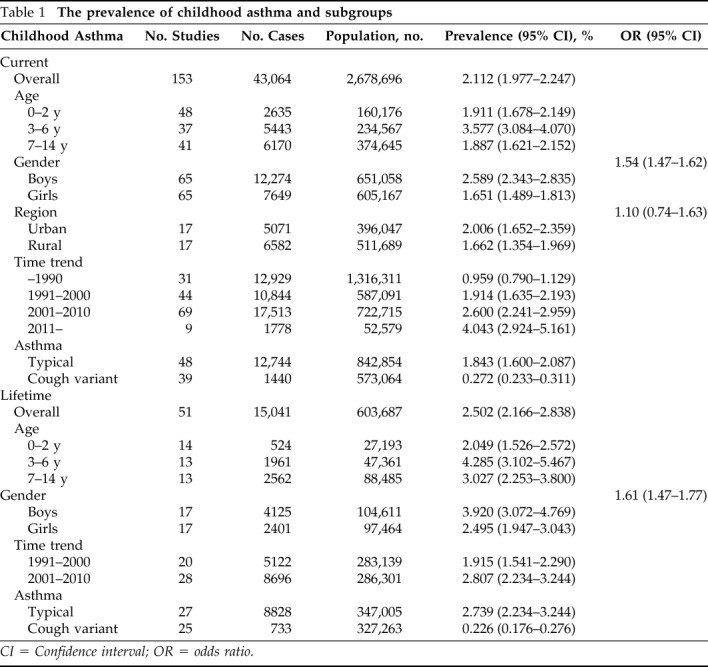
CI = Confidence interval; OR = odds ratio.
Prevalence of Childhood Asthma
Overall Prevalence
The current and the lifetime prevalences of childhood asthma were 2.112% (95% CI, 1.977–2.247%) and 2.502% (95% CI, 2.166–2.838%) (Fig. 2; Table 1).
Figure 2.
A forest plot for the current prevalence of childhood asthma.
Prevalence by Gender
The current and the lifetime prevalences for boys were 2.589% (95% CI, 2.343–2.835%) and 3.920% (95% CI, 3.072–4.769%). For girls, the current and the lifetime prevalences were 1.651% (95% CI, 1.489–1.813%) and 2.495% (95% CI, 1.947–3.043%). A significant difference was found between the genders (current: OR 1.54 [95% CI, 1.47–1.62]; lifetime: OR 1.61 [95% CI, 1.47–1.77]) (Fig. 3).
Figure 3.
A forest plot for the current prevalence of childhood asthma by gender.
Prevalence by Age Group
Based on the age distribution, the target populations were divided into infants (ages 0–2 years), preschoolers (ages 3–6 years), and school-age children (ages 7–14 years); the current prevalences of the three groups were 1.911% (95% CI, 1.578–2.149%), 3.577% (95% CI, 3.084–4.070%), and 1.887% (95% CI, 1.621–2.152%), respectively (Fig. 4); and the lifetime prevalences were 2.049% (95% CI, 1.526–2.572%), 4.285% (95% CI, 3.102–5.467%), and 3.027% (95% CI, 2.253–3.800%), respectively.
Figure 4.
The prevalence of childhood asthma by age group.
Prevalence by Year
Demonstrated in Fig. 5 is the time trend of the current prevalence of childhood asthma by year, from 1988 to 2014. The yearly pooled current prevalence values of childhood asthma in mainland China from 1996 to 2011 was used to fit the model (4, 1, 3), which illustrated no seasonal variation and a slightly increasing trend (Fig. 5). Log transformation and the nonseasonal (d = 1) difference were set to eliminate numerical instabilities. Also, we predicted the 5-year prevalence future of childhood asthma via a single ARIMA model (4, 1, 3). The predicted current prevalences in 2015, 2016, 2017, 2018, and 2019 were 3.234, 3.352, 3.296, 3.305, and 3.504% respectively, are shown in Attached Fig. 1.
Figure 5.
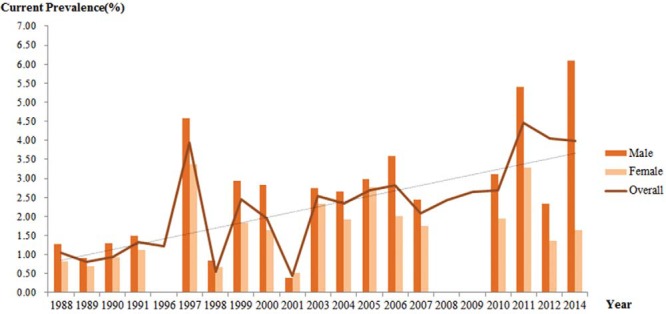
The current prevalence of childhood asthma by year.
The pooled current prevalences of childhood asthma in the past: 1990, 1991–2000, 2001–2010, and 2011 were 0.959% (95% CI, 0.790–1.129%), 1.914% (95% CI, 1.635–2.193%), 2.600% (95% CI, 2.241–2.959%), and 4.043% (95% CI, 2.924–5.161%), respectively. The lifetime prevalences in 1991–2000 and 2001–2010 were 1.915% (95% CI, 1.541–2.290%) and 2.807% (95% CI, 2.249–3.364%), respectively (Table 1).
Prevalence by Area
The current prevalence in urban and rural populations were 2.006% (95% CI, 1.652–2.359%) and 1.662% (95% CI, 1.354–1.969%), respectively. Only a few studies provided the individual lifetime prevalence in urban and rural areas, so the pooled lifetime prevalence in urban and rural areas were not provided. The pooled prevalences varied in different provinces, municipalities, and autonomous regions in mainland China. The current prevalence ranged from 0.251% (Tibet) to 4.418% (Zhejiang). The colored maps that show the regional distribution of the pooled prevalence in different decades (Figs. 6 and 7) indicate that the prevalences in the east coastal areas were higher than those in inland China. The prevalences in the southern areas were higher than those in the northern areas. Densely populated regions, such as Shanghai, Shandong, and Jiangsu, had higher prevalences than those of Tibet, Qinghai, and Sinkiang, which had small populations.
Figure 6.
Regional distribution of current prevalence of childhood asthma in mainland China.
Figure 7.
Regional distribution of lifetime prevalence of childhood asthma in mainland China.
Prevalence by Classification
The current and lifetime prevalences for typical asthma were 1.843% (95% CI, 1.600–2.087%) and 2.739% (95% CI, 2.234–3.244%), and the current and lifetime prevalences for cough-variant asthma (CVA) were 0.272% (95% CI, 0.233–0.311%) and 0.226% (95% CI, 0.176–0.276%).
Meta-Regression
Notable heterogeneity was found in this meta-analysis (all I2 > 50%; p < 0.001) (Table 2). Years of investigation, sample size, province (Anhui, Shandong, Shanghai, Zhejiang), territorial level (county), age group of target population, and gender were the factors considered to be sources of heterogeneity for the current prevalence of childhood asthma. As to lifetime prevalence, potential sources of heterogeneity were years of investigation, province (Shanghai), territorial level (city), and gender.
Table 2.
Meta-regression for prevalence of childhood asthma
Coef. = Regression coefficient; Ref. = reference category.
*The estimated prevalence was calculated separately.
Sensitivity Analysis
Sensitivity analysis was applied to examine the stability of our results. The overall current prevalence of childhood asthma was influenced after removing the National Cooperative Group on Childhood Asthma (NCGCA) 6 (Lasa), Ping et al.,94 Yan et al.,111 Sun,41 or Dong and Zhao61 (Tibet). The lifetime prevalences were affected by NCGCA6 (Lasa), NCGCA 20046 (Urumuqi), Ping et al.,94 NCGCA7 (Lasa), NCGCA7 (Linyi), and Chen et al.60
Publication Bias
A funnel plot indicated a publication bias (Online Supplemental fig. 2). Results of the Begg's test indicated a publication bias (current: z = 8.56, p < 0.001; and lifetime: z = 7.72, p < 0.001). Results of the Egger's test also indicated a significant value, current and lifetime: t = 16.64, p < 0.001; and t = 11.40, p < 0.001, respectively.
DISCUSSION
In 2012, Yangzong et al.10 reviewed studies on the epidemiology of childhood asthma in China, and 12 studies10 followed the ISAAC protocol,1 whereas 62 studies10 followed the two-stage Chinese diagnostic process. They reported generally low prevalences in both groups. The ISAAC survey124 was widely conducted worldwide and provided important information on the epidemiology of childhood asthma, but few ISAAC studies125–128 were held in mainland China after 2012. Studies12,63,77 in subregions of mainland China, especially a nationwide survey7 conducted in 2010, were conducted based on the Chinese diagnostic process. Questions on changes in the prevalence of childhood asthma in mainland China after 4 years were asked. Is there any variation among the populations, times, and regions? A meta-analysis that involved 117 studies that followed the two-stage Chinese diagnostic process with a total sample size of 2,678,696 in 1988–2014 was conducted for this reason.
Our results of childhood asthma in mainland China were consistent with the studies by Yangzong et al.10 (<3%) and Song et al.126 The results showed that the prevalences for current (2.112%) and lifetime (2.502%) were below the global average level.124 These results were definitely lower than that of some countries, such as the United States (current prevalence, 8.69%; lifetime prevalence, 12.06%),129 Australia (current prevalence, 11.3%; lifetime prevalence, 31%),130 Great Britain (current prevalence, 15.4%; lifetime prevalence, 27.3%),131 and Korea (current prevalence, 7.4%).132 We also estimated the prevalence of two types of asthma as follows: typical asthma (current, 1.843%; lifetime: 2.739%) and CVA (current, 0.272%; lifetime: 0.226%). Particularly, an erroneous diagnosis and a missed diagnosis happen frequently in cough-variant asthma. The NCGCA7 reported that only 58.6% of children who are ill were correctly diagnosed. Clinicians should attract enough attention to CVA, a particular form of asthma with chronic cough, which was often misdiagnosed as bronchitis.
The boys (current, 2.589%; lifetime, 3.920%) were at a significantly higher risk of childhood asthma than were the girls (current, 1.651%; lifetime, 2.495%) and constituted the majority of patients throughout most of their childhood, consistent with the previous studies.46,104,123 However, the current prevalence in girls surpasses that among boys during puberty. The condition persists among adults. Almqvist et al.133 found that hormonal changes and gender-specific differences in environmental exposures may influence the susceptibility to asthma. Similarly, Postma134 found that both hormonal changes and genetic susceptibility contribute to the difference in prevalences between the genders in puberty.
Preschoolers (3–6 years old) possessed the highest prevalence (current, 3.577%; lifetime, 4.285%). A similar condition was reported in two nationwide surveys in mainland China.6,7 Most of the preschoolers went to kindergarten, where many-to-one care for infants turned to one-to-many management. Staying in kindergarten may increase the risk of an upper respiratory infection, which was thought to be the main factor of childhood asthma131,135 for children who have a weak immune system and low self-management abilities. Children acquire strengthened self-management abilities and stronger immunity as they grew older and showed lower prevalence. Thus, the management of preschools and kindergarten should merit sufficient attention.
Although the prevalence of childhood asthma in mainland China was still low up to now, a rising trend from 1988 to the present was shown in the time-line chart presented (Fig. 5). Within the global scope, Asher et al.124 found that most countries showed an increased prevalence from ISAAC phases I to III,124 whereas some countries showed decreased prevalences. They also found that the decreases in the prevalences were more common in countries with existing high prevalence, such as Australia, South Korea, and Singapore. The principle of divergent trends requires further research. With concern to the increasing prevalence in mainland China, the epidemiologic transition along with the rapid development of China may have played a potential role. The intensifying environmental degradation (especially air pollution136), developing living quality (higher consultations), and behavioral changes (Western life style,10 decreased physical activity, high rates of smoking,126 mental stress,137 and other high-risk behaviors) accelerate the prevalence of childhood asthma.
The predicted prevalence in 2015 showed a slight decrease and remained stable in the next 4 years. Many policy, social, and medical factors (e.g., the promoting of the two-child policy in the recent years), all of which will affect the trend of the prevalence of childhood asthma. Ongoing monitoring is required to follow the epidemic of asthma. More attention should be given to promote reasonable disposition of health resources.
The current prevalences in urban and rural areas were 2.006 and 1.662%, respectively, without significant difference. However, some studies indicated that the prevalence in urban areas was higher.16,138,139 Ege et al.140 indicate that rural children exposed to a wider range of microbes than urban children so that they were less likely to develop asthma. However, most existing research19,32,38 focused on metropolises, and only a small number of studies16,19,43,111 focused on rural populations. Therefore, the comparison results may be insufficient to show the real state. Hence, the difference in the prevalences between urban and rural areas should still be taken into consideration.
A subgroup analysis by province was conducted, and the current prevalence ranged from 0.251% (Tibet) to 4.418% (Zhejiang). Highly developed regions demonstrated a higher prevalence than less-developed regions. The variation of the developments in different parts of China led to different epidemiologic circumstances. Air pollution, passive smoking, and a family history of respiratory disease are associated with children's asthma.141,142 Moreover, methods of cooking and heating may contribute to different prevalences of children's asthma in different regions of China. The availability of unified heating in cold days could be an important factor. The resulting difference between the behaviors and environment may have played an important role on the difference in prevalence.
High heterogeneity in a meta-analysis based on epidemiologic surveys is common.143,144 We conducted subgroup analyses and explored heterogeneity through meta-regression. Years of investigation, sample size, province (Zhejiang, Anhui, Shandong, and Shanghai), territorial level, age ranges of the study, and gender were considered to be the sources of heterogeneity. In response to this issue, we used the random-effect model and conducted subgroup analyses to examine the influence of these factors.
Several potential limitations cannot be ignored. First, the restriction of diagnosis tools and language contributed to the unavoidable publication bias that limited the accuracy of our results, although we attempted to discover all eligible studies in the literature. Second, despite the exclusion of studies with an unclear survey date or a small sample size (<1000) or the rigorous selection criteria for higher study qualities, some studies still scored low (<8). After carefully viewing the studies that affected the results, we discovered that these studies reported distinctly lower prevalences than others, which resulted in a lower estimated prevalence.
CONCLUSION
The prevalence of childhood asthma in mainland China was low but increased remarkably since 1998. Boys are more likely to have asthma throughout most of their childhood. Preschoolers (3–6 years old) showed a higher prevalence than the other age groups. The predicted current prevalences of childhood asthma fluctuated from 2015 to 2019, and increased slightly since 2017.
Footnotes
This study was supported by grants from the Foundation of Reform on Education and Teaching of Guangxi Medical University (grant 2013XJGB01), Guangxi Medical University Science Foundation for Youths (grant GXMUYSF2014033), and Found of Future Academic Start of Guangxi Medical University (WLXSZX17005)
The authors have no conflicts of interest to declare pertaining to this article
Supplemental data available at www.IngentaConnect.com
REFERENCES
- 1. Pearce N, Ait-Khaled N, Beasley R, et al. Worldwide trends in the prevalence of asthma symptoms: phase III of the International Study of Asthma and Allergies in Childhood (ISAAC). Thorax. 2007; 62:758–766. [DOI] [PMC free article] [PubMed] [Google Scholar]
- 2. Asher I, Pearce N. Global burden of asthma among children. Int J Tuberc Lung Dis. 2014; 18:1269–1278. [DOI] [PubMed] [Google Scholar]
- 3. Masoli M, Fabian D, Holt S, Beasley R, Global Initiative for Asthma (GINA) Program. The global burden of asthma: executive summary of the GINA Dissemination Committee report. Allergy. 2004; 59:469–478. [DOI] [PubMed] [Google Scholar]
- 4. Yang G, Kong L, Zhao W, et al. Emergence of chronic non-communicable diseases in China. Lancet. 2008; 372:1697–1705. [DOI] [PubMed] [Google Scholar]
- 5. Asthma tNCGoC. A nationwide survey in China on prevalence of childhood asthma in urban children. Chinese Journal of Pediatrics 2003:47–51. [PubMed] [Google Scholar]
- 6. Asthma tNCGoC. Comparation of the prevalence of childhood asthma in 2000 and 1990. Chinese Journal of Tuberculosis and Respiratory Diseases 2004:43–47. [Google Scholar]
- 7. National Cooperative Group on Childhood Asthma; Institute of Environmental Health and Related Product Safety, Chinese Center for Disease Control and Prevention; and Chinese Center for Disease Control and Prevention. Third nationwide survey of childhood asthma in urban areas of China [in Chinese with English abstract]. Zhonghua Er Ke Za Zhi. 2013; 51:729–735. [PubMed] [Google Scholar]
- 8. Ma H, Wang SL, Cheng L, et al. Epidemiological survey on asthma of 0–14 years old children in urban area of Xining City. J High Altitude Med 2013:60–64. [Google Scholar]
- 9. Wang YB, Wang Y, Song J. Epidemic tends analysis on childhood asthma in Weihai City between 2010 and 2012. China Health Care Nutrition 2013:588–589. [Google Scholar]
- 10. Yangzong Y, Shi Z, Nafstad P, Haheim LL, Luobu O, Bjertness E. The prevalence of childhood asthma in China: a systematic review. BMC Public Health. 2012; 12:860. [DOI] [PMC free article] [PubMed] [Google Scholar]
- 11. Zhang H, Wang XL, Gao Y, et al. Epidemiological survey of children asthma prevalence in Lanzhou urban area. Chinese Journal of Child Health Care 2015:1138–1141+1146. [Google Scholar]
- 12. Zhang YJ, Wang X, Ning LH, et al. Epidemiological investigation of asthma in children aged 0∼14 years in Inner Mongolia Autonomous Region, Baotou urban. J Applied Clin Pediatr. 2014; 29:1227–1231. [Google Scholar]
- 13. Song J, Li Q, Sun YH, et al. Analysis of childhood asthma in Weihai city. Maternal and Child Health Care of China 2013:4667–4668. [Google Scholar]
- 14. Von Elm E, Altman DG, Egger M, et al. The Strengthening the Reporting of Observational Studies in Epidemiology (STROBE) statement: guidelines for reporting observational studies. Lancet. 2007; 370:1453–1457. [DOI] [PubMed] [Google Scholar]
- 15. Liu Y, Shen QJ, Qiao F, et al. Investigation on asthma among 0–7 years old children in Yulin city. Chinese Journal of Pest Control 2015:1396–1399. [Google Scholar]
- 16. Liu YL, Tang SP, Wang SB, et al. Prevalence survey of asthma in 0–14 year old children in 2010 in urban and rural areas in Fuzhou of Fujian Province. Chinese Journal of Woman and Child Health Research 2015: 184–187, 188. [Google Scholar]
- 17. Ma XP, Qiao LP, Duo LK, et al. Epidemiological survey analysis of asthma children in Urumqi aged 0–14 years old and case-control study of it's risk factors. J Applied Clin Pediatr. 2015; 30:261–263. [Google Scholar]
- 18. Zhang J. Epidemiological investigation and risk factor analysis of asthma among children aged 0 to 14 years old in Taixing area. J Clin Pulmon Med. 2015:2249–2252. [Google Scholar]
- 19. Zhu WJ, Ma HX, Cui HY, et al. Prevalence and Treatment of Children's Asthma in Rural Areas Compared with Urban Areas in Beijing. Chin Med J (Engl). 2015; 128:2273–2277. [DOI] [PMC free article] [PubMed] [Google Scholar]
- 20. Chen XY. Survey analysis and research of the childhood asthma prevalence in Dongguan area. Chinese Journal of Urban and Rural Industrial Hygiene. 2015:102–104. [Google Scholar]
- 21. Feng QY. Epidemiological survey on bronchial asthma in Huairou county. Capital Food Med. 2015:24–26. [Google Scholar]
- 22. Li M, Li L, Jiang H, et al. Comparative analysis of 0–14 year old children with asthma in Chengdu city in 10 years. Modern Preventive Medicine 2015:239–241+251. [Google Scholar]
- 23. Yang YG, Wu JZ, Zhang JM, et al. Comparative analysis of epidemiological survey of childhood asthma in Xiamen. Chinese Journal of Practical Pediatrics 2014:918–921. [Google Scholar]
- 24. Zhang WP, Ma LJ, Wu JZ, et al. Asthma prevalence in Henan province and assessment of the status of disease control. International Journal of Epidemiology and Infectious Disease. 2014; 41:237–240. [Google Scholar]
- 25. Zhao K, Song GH, Gu HQ, Liu S, Zhang Y, Guo YR. Epidemiological survey and risk factor analysis of asthma in children in urban districts of Zhengzhou, China [in Chinese with English abstract]. Zhongguo Dang Dai Er Ke Za Zhi. 2014; 16:1220–1225. [PubMed] [Google Scholar]
- 26. Cheng F, Chen M, Zhong SH, et al. Epidemiological survey of asthma in children aged 0∼14 years old in the Tongan district of Xiamen China. Chinese Journal of Child Health Care. 2014:749–752. [Google Scholar]
- 27. Hu XG, Zhang HL, Li CC, et al. An epidemiological survey of pediatric asthma in urban area of Wenzhou city. Journal of Wenzhou Medical University 2014:804–809. [Google Scholar]
- 28. Kong T. Analysis of epidemiological investigation and prevention of childhood asthma. Clinical Journal of Chinese Medicine. 2014:27–28. [Google Scholar]
- 29. Qi ZY, Duan J, Zhang Q, et al. Epidemiological survey of childhood asthma in Kunming City, China [in Chinese with English abstract]. Zhongguo Dang Dai Er Ke Za Zhi. 2014; 16:910–913. [PubMed] [Google Scholar]
- 30. Wang XY, Liu CS, Wang Z, et al. Epidemiology characteristics of bronchial asthma in children aged 0–14 years old in Tianjin urban. Journal of Applied Clinical Pediatrics. 2014; 29:279–282. [Google Scholar]
- 31. Wu SX, Shen GL. An epidemiological study of bronchial asthma in Qinghai Province. Chinese Journal of Child Health Care. 2014; 22:1198–1200. [Google Scholar]
- 32. Association PrgoSm. Epidemiological survey of asthma in children aged 0∼14 years in seven districts of Shanghai. Chinese Journal of Pediatrics. 2014; 52:17–22. [PubMed] [Google Scholar]
- 33. Tan YB, Yang MQ, Li Y, et al. Epidemiological survey of childhood asthma in Changsha, Hunan. Journal of Clinical Research 2013:1442–1444. [Google Scholar]
- 34. Wang F, Wang M, Chen CB, et al. The epidemiological investigation of childhood asthma in Yichang city. Chinese Journal of Contemporary Pediatrics. 2013; 15:979–982. [DOI] [PubMed] [Google Scholar]
- 35. Wang JR, Li ZP, Jin Y, et al. Epidemiological survey of childhood asthma in urban area of Jinan city between 2010 and 2011. Journal of Applied Clinical Pediatrics. 2013; 28:778–780. [Google Scholar]
- 36. Wei Q, Nong GM, Jiang M, et al. A survey in Nanning city on prevalence of asthma in urban children under 15 year-old. Chinese Journal of Asthma (Electronic version) 2013:80–83. [Google Scholar]
- 37. Lin RJ, Liu YY, Lu L, et al. Epidemiological study of asthma in children aged 0–14 years old in Laoshan districts of Qingdao. Acta Aacademiae Medicinae Qingdao Universitatis 2013:512–514+517. [Google Scholar]
- 38. Liu CH, Shao MJ, Wang Q, et al. Epidemiological survey of children asthma prevalence in Beijing urban area [in Chinese with English abstract]. Zhonghua Yi Xue Za Zhi. 2013; 93:574–578. [PubMed] [Google Scholar]
- 39. Lv JH, Li WJ, Y.S. W, et al. Investigation on asthma in 0∼14 years old children in Baoji city. Chinese Journal of Child Health Care 2013;21:367–369. [Google Scholar]
- 40. Shi CH, Zhang W, Jing YH, et al. Epidemiological study on bronchial asthma among 0∼14 years old children in Jilin. Chinese Journal of Child Health Care 2013:645–648. [Google Scholar]
- 41. Sun W. Epidemiological analysis of asthma on children 0–14 years old in Shijiazhuang city: Hebei Medical University, 2013. [Google Scholar]
- 42. Gu JL. Epidemiological survey of asthma in children aged 0∼14 years in the Futian district of Shenzhen, China between 2010 and 2011: Zunyi Medical College, 2013. [PubMed] [Google Scholar]
- 43. Li M, Zhang Q, Shi WJ, et al. Epidemiological survey and analysis of asthma in children aged 0–14 years old in urban and rural areas of Chengdu region [in Chinese with English abstract]. Zhongguo Dang Dai Er Ke Za Zhi. 2013; 15:609–613. [PubMed] [Google Scholar]
- 44. Lu G, Jin R, Su SS, et al. Study on the prevalence and correlation factors of childhood asthma in Guiyang city. Guizhou Medical Journal 2012:1076–1079. [Google Scholar]
- 45. Xiong M. Children asthma's analysis of current incidence rate, distribution characteristics and risk factors in Hefei. Chinese Journal of Contemporary Pediatrics 2012. [Google Scholar]
- 46. Zhou BJ, Pan JH, Yu XK, et al. Epidemiological investigation on 0–14 childhood asthma in Huangshan District. Chinese Journal of Disease Control & Prevention 2012:268–270. [Google Scholar]
- 47. Ding Y. Epidemiological investigation and risk factors research of children asthma under 14 years old in Anqing city: Anhui Medical University, 2012. [Google Scholar]
- 48. Lei FL, Liu FX, Lan ZJ. Epidemiological analysis on asthma children aged 2–7 years old in Zhenhai. Ningbo Chinese Journal of Rural Medicine and Pharmacy. 2012; 19:64–65. [Google Scholar]
- 49. Li JW, Huang JY, Guo FM, et al. Epidemiological study on bronchial asthma among 0 to 14 years old children in Lecong Town. Chinese Medical Innovations 2012:99–100. [Google Scholar]
- 50. Liu JX, Zhu CH, Zhao XH, et al. Survey of asthma morbidity and present treatment of children aged 0∼14 in Suzhou. Chinese Journal of Child Health Care 2012:1019–1022. [Google Scholar]
- 51. Xie GH. Epidemiological analysis of asthma on children 6–12 years old in Changchun city: Jilin Medical University, 2011. [Google Scholar]
- 52. Zhong HG. Epidemiological analysis on childhood asthma in Longmen, Huizhou, Guangdong. Chinese and Foreign Medical Research 2011:61–62. [Google Scholar]
- 53. Association PrgoSm. Cluster survey on childhood asthma in 0–14 years old in Shanghai. Journal of Clinical Pediatrics 1994:107–109. [Google Scholar]
- 54. Association PrgoSm. Prevalence survey on bronchial asthma in 0–14 years old children in Shanghai. Journal of Clinical Pediatrics 2002:144–146+149. [Google Scholar]
- 55. Cen SN, Gong YN, Wei GQ, et al. Survey on prevalence rate of asthma in children in Foshan city. Chinese Journal of Child Health Care 2005:219–221. [Google Scholar]
- 56. Chen KH, Wu XF, Shi TT, et al. Epidemiological survey on childhood asthma in Chongqing area. Chongqing Medical Journal 1990:3–7. [Google Scholar]
- 57. Chen P, Yu RJ, Hou XM, et al. Epidemiological survey on bronchial asthma in Liaoning province [in Chinese with English abstract]. Zhonghua Jie He Hu Xi Za Zhi. 2002; 25:603–606. [PubMed] [Google Scholar]
- 58. Chen SH, Qiu SQ, Yan XQ, et al. Epidemiological survey on childhood asthma in our province. Jiangsu Medical Journal 1993:376–377. [Google Scholar]
- 59. Chen X, Xu MR, Lei M. A survey on the prevalence and the treatment of childhood asthma in Xianning. Journal of Xianning college(Medical version) 2007:76. [Google Scholar]
- 60. Chen YZ, Li Y, Liu SY, et al. Beijing area survey on bronchial asthma 40 thousand children. Beijing Medical Journal 1995:1–4. [Google Scholar]
- 61. Dong ZQ, Zhao WH. Epidemiological survey of childhood asthma on Central-South and South West Area in China. Journal of Practical Pediatrics 1993:42–44. [Google Scholar]
- 62. Feng YH, Lin DH, Liu F. Prevalence survey on childhood asthma in 3–14 years old in Xiangzhou. Zhuhai Central Plains Medical Journal. 2007; 34:56–57. [Google Scholar]
- 63. Feng YZ, Ma PR, Han XZ. Prevalence and epidemiological characteristics of asthma in Shandong Province. Journal of Shandong University 1994:212–215. [Google Scholar]
- 64. Gao F, Yang QJ, Zhang HG. An epidemiological study of bronchial asthma in Qinghai Province. Zhonghua Jie He He Hu Xi Za Zhi. [in Chinese with English abstract]. 2011; 34:165–168. [DOI] [PubMed] [Google Scholar]
- 65. Gao Y, Wang AH, Chen H, et al. Epidemiological survey on childhood asthma in Lanhou downtown. Chinese Journal of Epidemiology 2005:387. [Google Scholar]
- 66. Group A. Epidemiological survey on 10 thousand 0–14 years old children with asthma in Anqing downtown. Acta Universitatis Medicinalis Anhui 2002:241–242. [Google Scholar]
- 67. Group G. Epidemiological survey on 0–14 years old children's asthma in Lanzhou urban area. Journal of Lanzhou Medical College 1992:190–192. [Google Scholar]
- 68. Group L. A study on incidence of bronchial asthma and related factors in Children 0∼14 years of age in Liaoning. Pediatric Emergency Medicine 2002:11–13. [Google Scholar]
- 69. Group S. Epidemiological investigation on childhood asthma in Sichuan Area. Chongqing Medical Journal 1992. [Google Scholar]
- 70. Group S. Epidemiological survey on bronchial asthma of children in Sinkiang province. Sinkiang Medical Journal 1995:40–42. [Google Scholar]
- 71. Guo LC, Hu LR, Shen BR, et al. Epidemiological survey on childhood asthma in Ningxia. Ningxia Medical Journal 1992:67–70. [Google Scholar]
- 72. Hao CL, Zhang JH, Yan YD, et al. Sample analysis on childhood asthma in Jiangsu in 2000. Jiangsu Medical Journal 2002:617–618. [Google Scholar]
- 73. He QN, Liu JM, Cao Y, et al. Epidemiological survey on asthma of 0–14 years old children in Changsha in 2000. Hunan Medical Journal 2001:364–365. [Google Scholar]
- 74. He Y, Li SD, Zhang J. Epidemiological survey and analysis on childhood asthma in Shanxi province. Shanxi Medical Journal 1993:61. [Google Scholar]
- 75. Hong JX, Wang XY, Meng GJ, et al. Epidemiological survey on asthma under 14 year old in Xiaoshan city. Zhejiang Journal of Intergrated Traditional Chinese and Western Medicine 2000:64–66. [Google Scholar]
- 76. Huo KM, Zheng FL, Meng LP, et al. Cluster sampling survey on childhood asthma in Jiaozuo city. Central Plains Medical Journal 2000:13–14. [Google Scholar]
- 77. Jiang DZ, Yao L, Lu LJ, et al. Epidemiological survey on asthma of 40 thousand children in Guangxi. Guangxi Medical Journal 1993:162–164. [Google Scholar]
- 78. Jin L. Incidence and predisposing factors and associated risk factors of bronchial asthma in children in Xishan and Taigang in Taiyuan city: Shanxi Medical University, 2011. [Google Scholar]
- 79. Kong Y, Ren CY, Cheng YJ, et al. Epidemiological study on the sickness rate of asthma in children of 0∼14 years old in urban area of Huainan city. Chinese Journal of Child Health Care 2006:295–296. [Google Scholar]
- 80. Lei M, Zeng HY, Yu Y. Epidemiological investigation of bronchial asthma in Xianning City. Chinese Tropical Medicine 2005:258–260. [Google Scholar]
- 81. Li CC, Cai XH, Hu XG, et al. Epidemiological survey report on childhood asthma in Zhejiang Area in 2000. Zhejiang Medical Journal 2004:67–69. [Google Scholar]
- 82. Li L, Liu JM, Chen Q, et al. Epidemiological survey on asthma of 0–14 years old children in Nanchang urban area. Jiangxi Medical Journal 2011:1051–1052. [Google Scholar]
- 83. Li XD, Li L, Wu XY, et al. Epidemiological survey and analysis on asthma in Kaifeng urban area. Journal of Henan University (Medical version). 2006; 25:41–42. [Google Scholar]
- 84. Lin LY, Xu PC, Wu JC. Epedemiological survey of asthma in 0–14 years old children in Zhaoan. Fujian Medical Journal 1995:115–116. [Google Scholar]
- 85. Lin RC, Tian Q, Yue X, et al. Epidemiological survey on asthma of 0–14 years old children in Nanshan, Shenzhen. Chinese Journal of Child Health Care. 2005; 13:154–155. [Google Scholar]
- 86. Lin RJ, Wang WD, Pan YJ, et al. An epidemiological survey of 0–14-year-old children with asthma in Qingdao city proper. Acta Aacademiae Medicinae Qingdao Universitatis 2002:202–205. [Google Scholar]
- 87. Liu CS, Wan LY, Wang Z, et al. In Epidemiological survey on asthma of 12531 children in urban area of Tianjin. The first national conference of Chinese Association on Integrative, Medicine, Dalian, China, 2002. [Google Scholar]
- 88. Liu L, Lu JR, Cheng HJ, et al. Survey analysis of 0–14 years old children with asthma in Changchun city. Journal of Jilin University (Medical Version) 2005:149–151. [Google Scholar]
- 89. Liu SM, Wang XX, Liang QQ, et al. Epidemiological survey on asthma of children under 14 years old in the urban area of Shaoxin. The Journal of Practical Medicine 2006:2546–2547. [Google Scholar]
- 90. Lu WQ, Wang YF, Li B, et al. A survey and analysis on children's asthma of Guiyang city in 2000. Journal of Guiyang Medical College 2002:231–234. [Google Scholar]
- 91. Ma Y, Chen YZ, Chen ZL, et al. Epidemiological survey and analysis on children's asthma in Beijing in 2000. Beijing Medical Journal 2002:173–176. [Google Scholar]
- 92. Mo YX, Chen YH, Dai M, et al. Social economy evaluation on the epidemiological survey on childhood asthma in Kunming region. Journal of Clinical Pediatrics 2004:36–37+41. [Google Scholar]
- 93. Peng YL, Tang BX, Liu JG, et al. Epidemiological survey on childhood asthma in Henan province. Chinese Journal of Epidemiology 2001:76–77. [Google Scholar]
- 94. Ping W, Ma RC, Zhu JY, et al. Epidemiological survey on childhood asthma in Xining area. Chinese Journal of Child Health Care 2004:440–441. [Google Scholar]
- 95. Ren X, Wang LJ, Li ZL, et al. A survey on the prevalence of childhood asthma in Shaanxi province. Shaanxi Medical Journal 2004:88–90. [Google Scholar]
- 96. Ruan DB, Fan YC. Epidemiological survey on asthma of 0–14 years old children in Dongxiao. Tianjin Journal of Tianjin Medical University. 1991; 15:13–17. [Google Scholar]
- 97. Shen YD, Li YX, Li H, et al. The Prevalence of childhood asthma in Zhoukou city and analysis of the risk factor. Journal of School Health 2008:269–270. [Google Scholar]
- 98. Shi YM, Wang MQ, Ji HY, et al. Epidemiological investigation of asthma in children aged 0∼14 years old in Yuxi city. Journal of Kunming Medical College 2011:50–56. [Google Scholar]
- 99. Song YJ, Li Y, Wang KL, et al. An epidemiological survey of asthma in 0∼14-year-old children in Hebei Province. Hebei Medical Journal 2001:485–486. [Google Scholar]
- 100. Sun J, Yu XH, Yu JB, et al. The prevalence of childhood asthma in urban area of Harbin. Chinese Primary Health Care 2002:56. [Google Scholar]
- 101. Sun LB, Wang YT, Wan WJ, et al. Epidemiological investigation on children under 14 years old with asthma in Chaohu City. Chinese Journal of Disease Control & Prevention 2008:498–500. [Google Scholar]
- 102. Tang PW, Fang YP, Xie WZ, et al. Epidemiological survey on childhood asthma in Zhejiang Province. Zhejiang Medical Journal 1993:57–60. [Google Scholar]
- 103. Tang T, Ding Y, Zhen J, et al. Epidemiological survey and analysis on bronchial asthma in Guangdong province [in Chinese with English abstract]. Zhonghua Jie He He Hu Xi Za Zhi. 2000; 23:730–733. [PubMed] [Google Scholar]
- 104. Wang KX, Li ST, Yao LF, et al. Epidemiological survey on childhood asthma in Anqing city. Journal of School Health 1995:277. [Google Scholar]
- 105. Wang LJ, Ren X, Tian YZ, et al. Epidemiological investigation of asthma in children aged 0–14 years old in Xi'an city. Chinese Journal of Woman and Child Health Research. 2007; 18:88–89. [Google Scholar]
- 106. Wang LS, Wang LS, Li Y, et al. Epidemiological survey on 30 thousand children's asthma in Zunyi, Guizhou. Journal of Zunyi Medical College 1992:1–5. [Google Scholar]
- 107. Wang SF, Yu DY, Xu L. Epidemiological survey on childhood asthma in Jiangxi province. Journal of Jiangxi University of Traditional Chinese Medicine 1992:34–35+48. [Google Scholar]
- 108. Wang SY, Ding H, Wang SQ. Survey on prevalence rate of children with asthma in Zaozhaung city in 2004. Modern Preventive Medicine 2007:83–84+100. [Google Scholar]
- 109. Wang Y, Wu SG, Pan XJ, et al. The investigation and study of children's bronchial asthma of epidemiology in Nanhai district. Guide of China Medicine 2011:30–31. [Google Scholar]
- 110. Xu LL, Zheng H, Hua XL, et al. Report on the prevalence of 0∼14 years old children's asthma in Gulou county, Fuzhou City. Journal of Fujian Medical University 2001:376–379. [Google Scholar]
- 111. Yan CR, Li JY, Liu L, et al. Epidemiological survey on childhood asthma and recurrent respiratory tract infection in rural area of Cangzhou. Journal of Applied Clinical Pediatrics 1994:28–29. [Google Scholar]
- 112. Yao J, Ding S, Wang CH, et al. Sampling survey on childhood asthma in Nanjing city. Journal of Nanjing Medical University 2002:61–63. [Google Scholar]
- 113. Yuan D, Shen CL, Jiang ZH, et al. An investigation on the Prevalence of asthma and it's influence factors among school age children in Shanghai. Journal of Environmental & Occupational Medicine 2007:573–576. [Google Scholar]
- 114. Yuan HB, Cheng LY, Tao Y, et al. epidemiological survey on asthma in 0–14 years old children in Xiangtan city. In symposia of the conference of National Conference on Integrated Medicine in 2009 Hohhot, 2009, 220–220. [Google Scholar]
- 115. Zhang AP, Wang X, Shou QH, et al. Epidemiology investigation of asthma for children aged 0–14 in Baotou city. Chinese Medical Journal of Metallurgical Industry 2002:12–14. [Google Scholar]
- 116. Zhang SZ, Xi Q, Kong WS, et al. Study on prevalence and correlation factors of bronchial asthma in Zaozhuang area, Shandong province [in Chinese with English translation]. Zhonghua Liu Xing Bing Xue Za Zhi. 2005; 26:273–276. [PubMed] [Google Scholar]
- 117. Zhang YS, Wang DJ, Shen SM. Prevalence survey on childhood asthma in Fengxian county. Shanghai Journal of Preventive Medicine. 1997:346–348. [Google Scholar]
- 118. Zhao SW, Wang WG, Lu AP, et al. Prevalence survey on childhood asthma in downtown Taiyuan. Chinese Primary Health Care 2002:36–37. [Google Scholar]
- 119. Zhao YN, Lu PG, Li WJ, et al. Epidemiological survey on childhood asthma in urban area of Baoji city. Chinese Journal of Child Health Care 2003:283–284. [Google Scholar]
- 120. Zhao ZH, Zheng R, Yang LF, et al. The epidemiological investigation of bronchial asthma in Yunnan. Journal of Kunming Medical College 2008:66–70. [Google Scholar]
- 121. Zheng J. Epidemiological analysis on childhood asthma. Chinese and Foreign Medical Research. 2010; 08:176–177. [Google Scholar]
- 122. Zheng JY, Ma GW, Lin PY, et al. Primary epidemiological survey on childhood asthma in part of Shantou. Guangdong Medical Journal 1990:40–42. [Google Scholar]
- 123. Zheng LL, Ni C, Liu ZM, et al. Epidemiological study on bronchial asthma among 0∼14 years old children. Chinese Journal of Prevention and Control of Chronic Disease. 2003; 11:260–262. [Google Scholar]
- 124. Asher MI, Montefort S, Bjorksten B, et al. Worldwide time trends in the prevalence of symptoms of asthma, allergic rhinoconjunctivitis, and eczema in childhood: ISAAC Phases One and Three repeat multicountry cross-sectional surveys. Lancet. 2006; 368:733–743. [DOI] [PubMed] [Google Scholar]
- 125. Wang DX. Epidemiological Survey of Asthma in Jinan and the state and Significance of Thl7 cells in the different Phenotype of Asthma: Shandong University, 2013. [Google Scholar]
- 126. Song N, Shamssain M, Mohammed S, et al. Prevalence, severity and risk factors of asthma, rhinitis and eczema in a large group of Chinese schoolchildren. J Asthma 2014; 51:232–242. [DOI] [PubMed] [Google Scholar]
- 127. Huang C, Hu Y, Liu W, et al. The association between childhood asthma and pets feeding in Shanghai. Chinese Science Bulletin 2013:2538–2545. [Google Scholar]
- 128. Chen Y. The epidemiology of asthma in adolescents in urban and rural areas in Guangzhou: Guangzhou Medical College, 2011. [Google Scholar]
- 129. Bloom B, Jones LI, Freeman G. Summary health statistics for U.S. children: National Health Interview Survey, 2012. Vital Health Stat 10. 2013; (258):1–81. [PubMed] [Google Scholar]
- 130. Toelle BG, Ng K, Belousova E, Salome CM, Peat JK, Marks GB. Prevalence of asthma and allergy in schoolchildren in Belmont, Australia: three cross sectional surveys over 20 years. BMJ. 2004;328:386–387. [DOI] [PMC free article] [PubMed] [Google Scholar]
- 131. Burr ML, Wat D, Evans C, Dunstan FD, Doull IJ, British Thoracic Society Research Committee.. Asthma prevalence in 1973, 1988 and 2003. Thorax. 2006; 61:296–299. [DOI] [PMC free article] [PubMed] [Google Scholar]
- 132. Cho YM, Ryu SH, Choi MS, et al. Asthma and allergic diseases in preschool children in Korea: findings from the pilot study of the Korean Surveillance System for Childhood Asthma. J Asthma. 2014; 51:373–379. [DOI] [PubMed] [Google Scholar]
- 133. Almqvist C, Worm M, Leynaert B, working group of GA2LEN WP 2.5 Gender. Impact of gender on asthma in childhood and adolescence: a GA2LEN review. Allergy. 2008; 63:47–57. [DOI] [PubMed] [Google Scholar]
- 134. Postma DS. Gender differences in asthma development and progression. Gend Med. 2007; (suppl B):S133–S146. [DOI] [PubMed] [Google Scholar]
- 135. Liu CH, Chen YZ. Epidemiology and statu analysis on treatment and prevention in childhood asthma. Chinese Journal of Practical Pediatrics 2013. [Google Scholar]
- 136. Clark NA, Demers PA, Karr CJ, et al. Effect of early life exposure to air pollution on development of childhood asthma. Environ Health Perspect. 2010; 118:284–290. [DOI] [PMC free article] [PubMed] [Google Scholar]
- 137. Li F, Zhou Y, Li S, et al. Prevalence and risk factors of childhood allergic diseases in eight metropolitan cities in China: a multicenter study. BMC Public Health. 2011; 11:437. [DOI] [PMC free article] [PubMed] [Google Scholar]
- 138. Jin Y, Zhang LY. A Regression Analysis of Epidemiological Survey in Domestic Children with Asthma. Chinese Archives of Traditional Chinese Medicine 2012. [Google Scholar]
- 139. Wong GW, Chow CM. Childhood asthma epidemiology: insights from comparative studies of rural and urban populations. Pediatr Pulmonol. 2008; 43:107–116. [DOI] [PubMed] [Google Scholar]
- 140. Ege MJ, Mayer M, Normand AC, et al. Exposure to environmental microorganisms and childhood asthma. N Engl J Med. 2011; 364:701–709. [DOI] [PubMed] [Google Scholar]
- 141. Pan G, Zhang S, Feng Y, et al. Air pollution and children's respiratory symptoms in six cities of Northern China. Respir Med. 2010; 104:1903–1911. [DOI] [PubMed] [Google Scholar]
- 142. Lin W, Huang W, Zhu T, et al. Acute respiratory inflammation in children and black carbon in ambient air before and during the 2008 Beijing Olympics. Environ Health Perspect. 2011; 119:1507–1512. [DOI] [PMC free article] [PubMed] [Google Scholar]
- 143. Mitchell AJ, Chan M, Bhatti H, et al. Prevalence of depression, anxiety, and adjustment disorder in oncological, haematological, and palliative-care settings: a meta-analysis of 94 interview-based studies. Lancet Oncol. 2011; 12:160–174. [DOI] [PubMed] [Google Scholar]
- 144. Winsper C, Ganapathy R, Marwaha S, Large M, Birchwood M, Singh SP. A systematic review and meta-regression analysis of aggression during the first episode of psychosis. Acta Psychiatr Scand 2013; 128:413–421. [DOI] [PubMed] [Google Scholar]
Associated Data
This section collects any data citations, data availability statements, or supplementary materials included in this article.




